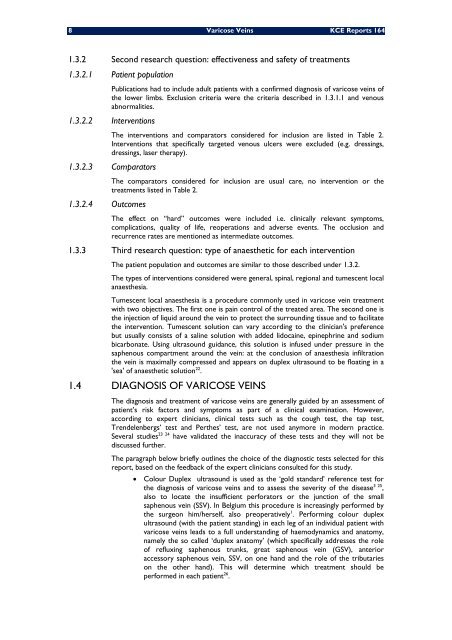Diagnostic et traitement des varices des membres inférieurs - KCE
Diagnostic et traitement des varices des membres inférieurs - KCE
Diagnostic et traitement des varices des membres inférieurs - KCE
Create successful ePaper yourself
Turn your PDF publications into a flip-book with our unique Google optimized e-Paper software.
8 Varicose Veins <strong>KCE</strong> Reports 164<br />
1.3.2 Second research question: effectiveness and saf<strong>et</strong>y of treatments<br />
1.3.2.1 Patient population<br />
Publications had to include adult patients with a confirmed diagnosis of varicose veins of<br />
the lower limbs. Exclusion criteria were the criteria <strong>des</strong>cribed in 1.3.1.1 and venous<br />
abnormalities.<br />
1.3.2.2 Interventions<br />
The interventions and comparators considered for inclusion are listed in Table 2.<br />
Interventions that specifically targ<strong>et</strong>ed venous ulcers were excluded (e.g. dressings,<br />
dressings, laser therapy).<br />
1.3.2.3 Comparators<br />
The comparators considered for inclusion are usual care, no intervention or the<br />
treatments listed in Table 2.<br />
1.3.2.4 Outcomes<br />
The effect on “hard” outcomes were included i.e. clinically relevant symptoms,<br />
complications, quality of life, reoperations and adverse events. The occlusion and<br />
recurrence rates are mentioned as intermediate outcomes.<br />
1.3.3 Third research question: type of anaesth<strong>et</strong>ic for each intervention<br />
The patient population and outcomes are similar to those <strong>des</strong>cribed under 1.3.2.<br />
The types of interventions considered were general, spinal, regional and tumescent local<br />
anaesthesia.<br />
Tumescent local anaesthesia is a procedure commonly used in varicose vein treatment<br />
with two objectives. The first one is pain control of the treated area. The second one is<br />
the injection of liquid around the vein to protect the surrounding tissue and to facilitate<br />
the intervention. Tumescent solution can vary according to the clinician's preference<br />
but usually consists of a saline solution with added lidocaine, epinephrine and sodium<br />
bicarbonate. Using ultrasound guidance, this solution is infused under pressure in the<br />
saphenous compartment around the vein: at the conclusion of anaesthesia infiltration<br />
the vein is maximally compressed and appears on duplex ultrasound to be floating in a<br />
'sea' of anaesth<strong>et</strong>ic solution 22 .<br />
1.4 DIAGNOSIS OF VARICOSE VEINS<br />
The diagnosis and treatment of varicose veins are generally guided by an assessment of<br />
patient’s risk factors and symptoms as part of a clinical examination. However,<br />
according to expert clinicians, clinical tests such as the cough test, the tap test,<br />
Trendelenbergs’ test and Perthes’ test, are not used anymore in modern practice.<br />
Several studies 23 24 have validated the inaccuracy of these tests and they will not be<br />
discussed further.<br />
The paragraph below briefly outlines the choice of the diagnostic tests selected for this<br />
report, based on the feedback of the expert clinicians consulted for this study.<br />
• Colour Duplex ultrasound is used as the ‘gold standard’ reference test for<br />
the diagnosis of varicose veins and to assess the severity of the disease 3 25 ,<br />
also to locate the insufficient perforators or the junction of the small<br />
saphenous vein (SSV). In Belgium this procedure is increasingly performed by<br />
the surgeon him/herself, also preoperatively 1 . Performing colour duplex<br />
ultrasound (with the patient standing) in each leg of an individual patient with<br />
varicose veins leads to a full understanding of haemodynamics and anatomy,<br />
namely the so called ‘duplex anatomy’ (which specifically addresses the role<br />
of refluxing saphenous trunks, great saphenous vein (GSV), anterior<br />
accessory saphenous vein, SSV, on one hand and the role of the tributaries<br />
on the other hand). This will d<strong>et</strong>ermine which treatment should be<br />
performed in each patient 26 .

















